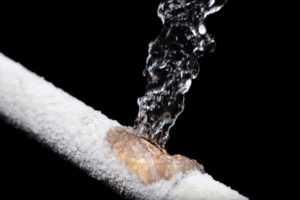Don’t let frozen pipes happen to you
Mid-January can bring mid-winter deep-freezes, which are nothing to take lightly or to assume it won’t happen to you.
“It” is the destructive power of a frozen and/or burst pipe in your home or business.
When water freezes, it expands, which causes pressure on whatever the water is contained in – a pipe, water bottle, hose, etc. If that pressure goes unnoticed, it could cause the container to crack and even burst, both of which could send gallons upon gallons of water through your building leaving thousands of dollars in damage in its wake. It’s important to remember that not all pipes that are frozen will burst, but the sooner you act upon a frozen pipe, the better.
So how do you spot a frozen pipe?
- The pipe itself may have a distinct bulge or be covered in frost. Your water pressure may decrease or stop altogether, and your toilet may not refill after you flush it.
Where are frozen pipes most likely to occur?
- Exterior walls (i.e., kitchen sink, bathrooms sink and toilet, etc.) and uninsulated areas like basements and attics.
It’s important to remember that not all plumbing pipes are visible in your home or building – walls and floors can obstruct a direct view.
What should you do if you think you have a frozen pipe?
- Help reduce the pressure building within your pipes by shutting off the water to the home or building. When the ice has thawed and water resumes flowing normally, the initial gush of water could cause flooding. You should also shut off the electricity to that part of the home or building if you can – water and electricity do not mix.
- Do not use an open flame or flammable tools to thaw the pipe. Instead, use a hair dryer or place warm blankets or towels around the pipe to slowly thaw the pipe. If you use a space heater, do not leave it unattended or have it touch anything that could catch on fire.
- To test to see if you have successfully thawed the pipe, turn the water back on and test the faucet. If water flow has returned, keep the faucet open – running water will help clear any remaining ice in the pipe. Do not leave a running faucet unattended.
- Be sure to check other pipes in your home or building, especially along the same wall. If one of your pipes as frozen, you may have others as well.
What should you do to try and avoid frozen pipes?
- Make sure the thermostat is no lower than 55 degrees. If you will be away, make sure it is set to come on automatically.
- To allow warm air to circulate around pipes you can see, keep cupboard doors open. Allow your water to trickle from the faucet to keep water flow going. Make sure the drain is completely clear, and that no harmful cleaning chemicals and other material is available to small children or pets.
- Before winter arrives, add insulation where it is lacking in unheated areas of the home or building – garage, crawl space, attic, basement, etc. – and continue to check pipes often through the winter months.




